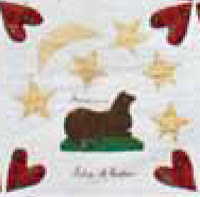One question I am often asked goes something like this: I have a quilt I want to donate to a museum. How do I choose one?
You have to find a good match for the quilt and the museum.
With taxpayers refusing to fund the arts and humanities, museums are taking fewer quilts. You have to sell the quilt (so to speak) to the museum acquisitions committee. (Don't try to actually sell it---they have very little money to spend.)
Different types of museums are interested in different types of quilts. If the quilt has fabulous graphics, like the two above, you might want to approach an art museum.
Quilt dated 1795---
Any early quilt probably has a good chance of being accepted.
This one is in the collection of the Smithsonian Institution---a very good home.
Mid 19th century samplers like this often are signed with place names. This would be a treasure for any museum, and particularly for one in the area where it was made.
I've donated two quilts in the last year and I chose both museums based on the quilts' histories.
A whitework quilt made by the
Mennonite church in Halsted, Kansas, about 1960
The white wholecloth quilt above went to the Kaufman Museum at Bethel College, a Mennonite school. The reason I asked them and the reason they were glad to get it was that it was a Mennonite quilt. More than that it---was made in Halsted, near the school and commissioned by the wife of a former president of the college. I knew all this provenance because it was a family quilt and I thought it would be a good idea to get it all written down and in their hands now.
I photographed the quilt, described its history and made a proposal. I included information about its condition and pointed out a water stain in the center.
Their acquisitions committee met and agreed to take it. I was thrilled because this seemed the perfect home.
The other quilt is the crazy quilt I blogged about a few weeks ago---the tattered piece that I really knew nothing about. I immediately noticed it was from Michigan and had commemorative ribbons from early-20th-century Michigan gatherings. Even though we had no idea who made it I thought it would be a prize for a history museum in Michigan.
See that post here:
http://barbarabrackman.blogspot.com/2012/04/womens-relief-corps-quilt.html
My first thought was the Museum at Michigan State University, which not only has a great quilt collection but a focus on the social context of quiltmaking. The quilt was in terrible shape but it is still a social document. Their acquisitions committee also agreed.
Beth in their collections department wrote me a note:
"We’ll be working on getting the individual ribbons photographed so we can add the quilt to the Quilt Index. We will also be stitching netting on the areas that are shattering. This will take quite a bit of time. We here in Michigan are so happy that the unknown lady found you and that you thought of us."
Another good home.
Had they not taken it I'd made a list of other options---e.g. local history museums in counties where the ribbons originated. Maybe a museum interested in Civil War history.
When you are considering a home here are two things you should NOT consider.
Early quilt now in the collection of the Museum at
Michigan State University with serious damage
caused by long-term display in another museum
One is whether the quilt will be on permanent display. I cannot tell you how many people write and say this is their major criteria for a good home. It's NOT, NOT, NOT in the best interests of any textile to be on permanent display. See more about this damaged chintz quilt by clicking here:http://museum.msu.edu/glqc/collections_11396CW.html




















































